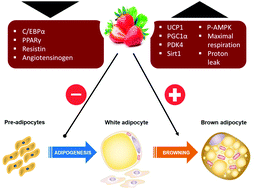当前位置:
X-MOL 学术
›
Food Funct.
›
论文详情
Our official English website, www.x-mol.net, welcomes your
feedback! (Note: you will need to create a separate account there.)
Strawberry (Fragaria × ananassa cv. Romina) methanolic extract promotes browning in 3T3-L1 cells.
Food & Function ( IF 5.1 ) Pub Date : 2020-01-09 , DOI: 10.1039/c9fo02285f Tamara Y Forbes-Hernández 1 , Danila Cianciosi , Johura Ansary , Bruno Mezzetti , Stefano Bompadre , Josè L Quiles , Francesca Giampieri , Maurizio Battino
Food & Function ( IF 5.1 ) Pub Date : 2020-01-09 , DOI: 10.1039/c9fo02285f Tamara Y Forbes-Hernández 1 , Danila Cianciosi , Johura Ansary , Bruno Mezzetti , Stefano Bompadre , Josè L Quiles , Francesca Giampieri , Maurizio Battino
Affiliation

|
In recent years, the conversion of white adipocytes to brown-like adipocytes by pharmacological and dietary compounds has gained attention as an effective strategy to fight obesity. Strawberry bioactive compounds present several biological activities including antioxidant, anti-inflammatory, anti-cancer, anti-atherosclerotic and antiadipogenic properties. However, to the best of our knowledge, the possible role of strawberry bioactive compounds in white adipose tissue (WAT) browning has never been explored. Our results demonstrated that a strawberry methanolic extract (SE) significantly reduced 3T3-L1 pre-adipocytes differentiation, and down-regulated the mRNA expression of the adipogenic transcription factors CCAAT/enhancer-binding protein (C/REB- α) and peroxisome proliferation-activated receptor (PPAR-γ). It also down-regulated the mRNA expression of resistin and angiotensinogen, two genes considered as markers of white adipocytes, while increased the mRNA expression of pyruvate dehydrogenase lipoamide kinase isozyme 4 (PDK4) and uncoupling protein 1 (UCP1) which, conversely, are brown adipocyte-specific markers. Likewise, SE stimulated AMP-activated protein kinase (AMPKα), sirtuin 1 (Sirt1) and the peroxisome proliferator activated receptor gamma coactivator 1-alpha (PGC-1α), suggesting a possible increase in mitochondrial biogenesis. It also stimulated oxygen consumption rate and uncoupled respiration. Taken together, all these results suggest that SE induces brown fat-like phenotype in 3T3-L1 cells and may have potential therapeutic implications for treatment and/or prevention of obesity.
中文翻译:

草莓(Fragaria×ananassa cv。Romina)甲醇提取物可促进3T3-L1细胞褐变。
近年来,作为治疗肥胖的有效策略,通过药理和饮食化合物将白色脂肪细胞转化为褐色脂肪细胞已受到关注。草莓生物活性化合物具有多种生物活性,包括抗氧化,抗炎,抗癌,抗动脉粥样硬化和抗脂肪形成特性。然而,就我们所知,草莓生物活性化合物在白色脂肪组织(WAT)褐变中的可能作用尚未得到探讨。我们的结果表明,草莓甲醇提取物(SE)显着降低了3T3-L1前脂肪细胞的分化,并下调了脂肪形成转录因子CCAAT /增强子结合蛋白(C / REB-α)的mRNA表达和过氧化物酶体增殖,激活受体(PPAR-γ)。它也下调了被认为是白色脂肪细胞标志物的两个基因抵抗素和血管紧张素原的mRNA表达,同时增加了丙酮酸脱氢酶脂酰胺激酶同工酶4(PDK4)和解偶联蛋白1(UCP1)的棕色mRNA表达。脂肪细胞特异性标志物。同样,SE刺激AMP激活的蛋白激酶(AMPKα),sirtuin 1(Sirt1)和过氧化物酶体增殖物激活的受体γ辅激活物1-alpha(PGC-1α),提示线粒体的生物发生可能增加。它还刺激了耗氧率和无呼吸作用。综上所述,所有这些结果表明,SE在3T3-L1细胞中诱导褐色脂肪样表型,并且可能对肥胖症的治疗和/或预防具有潜在的治疗意义。两个基因被认为是白色脂肪细胞的标志物,而丙酮酸脱氢酶脂酰胺激酶同工酶4(PDK4)和解偶联蛋白1(UCP1)的mRNA表达增加,而丙酮酸脱氢酶脂蛋白激酶同工酶4是棕色脂肪细胞特异性标志物。同样,SE刺激AMP激活的蛋白激酶(AMPKα),sirtuin 1(Sirt1)和过氧化物酶体增殖物激活的受体γ辅激活物1-alpha(PGC-1α),表明线粒体的生物发生可能增加。它还刺激了耗氧率和无呼吸作用。综上所述,所有这些结果表明,SE在3T3-L1细胞中诱导褐色脂肪样表型,并且可能对肥胖症的治疗和/或预防具有潜在的治疗意义。两个基因被认为是白色脂肪细胞的标志物,而丙酮酸脱氢酶脂酰胺激酶同工酶4(PDK4)和解偶联蛋白1(UCP1)的mRNA表达增加,而丙酮酸脱氢酶脂蛋白激酶同工酶4是棕色脂肪细胞特异性标志物。同样,SE刺激AMP激活的蛋白激酶(AMPKα),sirtuin 1(Sirt1)和过氧化物酶体增殖物激活的受体γ辅激活物1-alpha(PGC-1α),表明线粒体的生物发生可能增加。它还刺激了耗氧率和无呼吸作用。综上所述,所有这些结果表明,SE在3T3-L1细胞中诱导褐色脂肪样表型,并且可能对肥胖症的治疗和/或预防具有潜在的治疗意义。同时增加了丙酮酸脱氢酶脂酰胺激酶同工酶4(PDK4)和解偶联蛋白1(UCP1)的mRNA表达,而后者是棕色脂肪细胞特异性标志物。同样,SE刺激AMP激活的蛋白激酶(AMPKα),sirtuin 1(Sirt1)和过氧化物酶体增殖物激活的受体γ辅激活物1-alpha(PGC-1α),表明线粒体的生物发生可能增加。它还刺激了耗氧率和无呼吸作用。综上所述,所有这些结果表明,SE在3T3-L1细胞中诱导褐色脂肪样表型,并且可能对肥胖症的治疗和/或预防具有潜在的治疗意义。同时增加了丙酮酸脱氢酶脂酰胺激酶同工酶4(PDK4)和解偶联蛋白1(UCP1)的mRNA表达,而后者是棕色脂肪细胞特异性标志物。同样,SE刺激AMP激活的蛋白激酶(AMPKα),sirtuin 1(Sirt1)和过氧化物酶体增殖物激活的受体γ辅激活物1-alpha(PGC-1α),表明线粒体的生物发生可能增加。它还刺激了耗氧率和无呼吸作用。综上所述,所有这些结果表明,SE在3T3-L1细胞中诱导褐色脂肪样表型,并且可能对肥胖症的治疗和/或预防具有潜在的治疗意义。sirtuin 1(Sirt1)和过氧化物酶体增殖物激活受体γ辅激活物1-alpha(PGC-1α),表明线粒体的生物发生可能增加。它还刺激了耗氧率和无呼吸作用。综上所述,所有这些结果表明,SE在3T3-L1细胞中诱导褐色脂肪样表型,并且可能对肥胖症的治疗和/或预防具有潜在的治疗意义。sirtuin 1(Sirt1)和过氧化物酶体增殖物激活受体γ辅激活物1-alpha(PGC-1α),表明线粒体的生物发生可能增加。它还刺激了耗氧率和无呼吸作用。综上所述,所有这些结果表明,SE在3T3-L1细胞中诱导褐色脂肪样表型,并且可能对肥胖症的治疗和/或预防具有潜在的治疗意义。
更新日期:2020-02-13
中文翻译:

草莓(Fragaria×ananassa cv。Romina)甲醇提取物可促进3T3-L1细胞褐变。
近年来,作为治疗肥胖的有效策略,通过药理和饮食化合物将白色脂肪细胞转化为褐色脂肪细胞已受到关注。草莓生物活性化合物具有多种生物活性,包括抗氧化,抗炎,抗癌,抗动脉粥样硬化和抗脂肪形成特性。然而,就我们所知,草莓生物活性化合物在白色脂肪组织(WAT)褐变中的可能作用尚未得到探讨。我们的结果表明,草莓甲醇提取物(SE)显着降低了3T3-L1前脂肪细胞的分化,并下调了脂肪形成转录因子CCAAT /增强子结合蛋白(C / REB-α)的mRNA表达和过氧化物酶体增殖,激活受体(PPAR-γ)。它也下调了被认为是白色脂肪细胞标志物的两个基因抵抗素和血管紧张素原的mRNA表达,同时增加了丙酮酸脱氢酶脂酰胺激酶同工酶4(PDK4)和解偶联蛋白1(UCP1)的棕色mRNA表达。脂肪细胞特异性标志物。同样,SE刺激AMP激活的蛋白激酶(AMPKα),sirtuin 1(Sirt1)和过氧化物酶体增殖物激活的受体γ辅激活物1-alpha(PGC-1α),提示线粒体的生物发生可能增加。它还刺激了耗氧率和无呼吸作用。综上所述,所有这些结果表明,SE在3T3-L1细胞中诱导褐色脂肪样表型,并且可能对肥胖症的治疗和/或预防具有潜在的治疗意义。两个基因被认为是白色脂肪细胞的标志物,而丙酮酸脱氢酶脂酰胺激酶同工酶4(PDK4)和解偶联蛋白1(UCP1)的mRNA表达增加,而丙酮酸脱氢酶脂蛋白激酶同工酶4是棕色脂肪细胞特异性标志物。同样,SE刺激AMP激活的蛋白激酶(AMPKα),sirtuin 1(Sirt1)和过氧化物酶体增殖物激活的受体γ辅激活物1-alpha(PGC-1α),表明线粒体的生物发生可能增加。它还刺激了耗氧率和无呼吸作用。综上所述,所有这些结果表明,SE在3T3-L1细胞中诱导褐色脂肪样表型,并且可能对肥胖症的治疗和/或预防具有潜在的治疗意义。两个基因被认为是白色脂肪细胞的标志物,而丙酮酸脱氢酶脂酰胺激酶同工酶4(PDK4)和解偶联蛋白1(UCP1)的mRNA表达增加,而丙酮酸脱氢酶脂蛋白激酶同工酶4是棕色脂肪细胞特异性标志物。同样,SE刺激AMP激活的蛋白激酶(AMPKα),sirtuin 1(Sirt1)和过氧化物酶体增殖物激活的受体γ辅激活物1-alpha(PGC-1α),表明线粒体的生物发生可能增加。它还刺激了耗氧率和无呼吸作用。综上所述,所有这些结果表明,SE在3T3-L1细胞中诱导褐色脂肪样表型,并且可能对肥胖症的治疗和/或预防具有潜在的治疗意义。同时增加了丙酮酸脱氢酶脂酰胺激酶同工酶4(PDK4)和解偶联蛋白1(UCP1)的mRNA表达,而后者是棕色脂肪细胞特异性标志物。同样,SE刺激AMP激活的蛋白激酶(AMPKα),sirtuin 1(Sirt1)和过氧化物酶体增殖物激活的受体γ辅激活物1-alpha(PGC-1α),表明线粒体的生物发生可能增加。它还刺激了耗氧率和无呼吸作用。综上所述,所有这些结果表明,SE在3T3-L1细胞中诱导褐色脂肪样表型,并且可能对肥胖症的治疗和/或预防具有潜在的治疗意义。同时增加了丙酮酸脱氢酶脂酰胺激酶同工酶4(PDK4)和解偶联蛋白1(UCP1)的mRNA表达,而后者是棕色脂肪细胞特异性标志物。同样,SE刺激AMP激活的蛋白激酶(AMPKα),sirtuin 1(Sirt1)和过氧化物酶体增殖物激活的受体γ辅激活物1-alpha(PGC-1α),表明线粒体的生物发生可能增加。它还刺激了耗氧率和无呼吸作用。综上所述,所有这些结果表明,SE在3T3-L1细胞中诱导褐色脂肪样表型,并且可能对肥胖症的治疗和/或预防具有潜在的治疗意义。sirtuin 1(Sirt1)和过氧化物酶体增殖物激活受体γ辅激活物1-alpha(PGC-1α),表明线粒体的生物发生可能增加。它还刺激了耗氧率和无呼吸作用。综上所述,所有这些结果表明,SE在3T3-L1细胞中诱导褐色脂肪样表型,并且可能对肥胖症的治疗和/或预防具有潜在的治疗意义。sirtuin 1(Sirt1)和过氧化物酶体增殖物激活受体γ辅激活物1-alpha(PGC-1α),表明线粒体的生物发生可能增加。它还刺激了耗氧率和无呼吸作用。综上所述,所有这些结果表明,SE在3T3-L1细胞中诱导褐色脂肪样表型,并且可能对肥胖症的治疗和/或预防具有潜在的治疗意义。









































 京公网安备 11010802027423号
京公网安备 11010802027423号